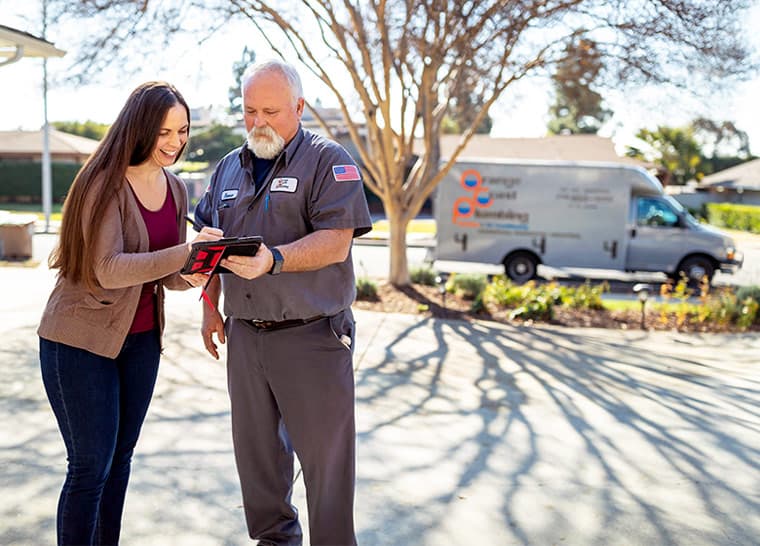Poor drainage is annoying at best and problematic at worst. The problem never gets better on its own.
Wishing it away won’t make it go away; you may end up with a complete blockage unless you take action.
The first sign of poor drainage is that it takes longer than usual for water to travel down the pipe. Water may fill the sink, shower, or tub even when the drain is open or look different as it goes down.
The trick is to discover the problem, troubleshoot it, and fix it before it causes genuine inconvenience and damage. Here are the five most common causes of poor drainage in a home.
1. A Blocked or Broken Connection in the Main Line to the Septic Tank or Sewer System
Of all the reasons for poor drainage, this is the worst, requiring extensive and expensive repairs and potentially invasive measures to reach the clogged line. The main sewer line can fail because of:
- Old and corroded pipes
- Tree roots in the lines
- Natural phenomena like earthquakes
How can you determine if the main sewer line is involved? You’ll notice that all your drains are draining slower, since all house drains use the connection. Call a certified plumber to run diagnostics for you and propose a solution. Repairing a clogged main sewer line is no job for amateurs and may require a permit from the city.
2. Drain Clogs from Debris & Gunk
This problem occurs more in bathroom drains due to hair, soap scum, and other stuff that can accumulate in pipes. But it can also affect kitchen sinks, especially if you don’t use strainers to collect food particles and other debris.
A quick snaking will often remove the clog and restore the drain to normal, or even a wire hanger, if the clog isn’t too far down the pipe. But if you can’t unclog the drain on your own, a plumber will make quick work of it and clear the drain to a near-new condition.
3. Improper Use of Drains
You’d be amazed at some of the stuff people flush — or attempt to flush — down the toilets. Children’s toys? You’ve heard that one.
Feminine hygiene products and diaper wipes are among the usual suspects. But diapers? Cat litter? Most brands of cat litter turn to concrete when exposed to water.
As a rule, you should only flush toilet paper and the waste that goes with it. However, you can’t monitor guests in the bathroom, and kids are a complete wild card. They’ll throw just about anything in the loo and pull the handle to see what happens.
You, of course, have already guessed what happens. You call the plumber because you don’t have the tools or expertise to salvage Billy’s fire truck. For everything else, you have the plunger, and the plumber as backup when the plunger fails.
4. Grease & Oil Clogs
You’ve done your due diligence, using strainers in the kitchen sink almost to the point of fanaticism. Still, you end up with standing water when you pull the plug.
What gives? Chances are you have a grease and oil clog. Grease and oil to cool quickly in the metal pipes, sticking to them. Over the years, they build up, and the drain no longer functions correctly.
A safe drain cleaner should clear the clog (choose a cleaner that won’t damage pipes); in the future, find another way to dispose of grease and oil, like a collection can that gets tossed when it reaches capacity.
5. Old, Corroded Pipes with Inadequate Drainage Capacity
There’s no DIY remedy for old pipes. It’s time to call the plumber. However, you may only have to repipe part of your sewer line system. A plumber can give the lay of the land. Options include:
- Complete repiping
- Partial repiping
- Pipe bursting, where a new pipe is pulled through to replace the old pipe
- Cured-in-place pipe repair, where existing pipes are cleared and relined with mesh fabric and special plastic
Most sewer pipes last for at least 60 years, but tree roots, shifting soil, and corrosive chemicals can damage them beyond repair. Only a plumber will know for sure.
Call us for an assessment, and we’ll let you know if there’s a simple fix. If there isn’t, we’ll suggest a minimally invasive and affordable solution.
FAQs: Causes of Sewer Poor Drainage
Q: What are the common signs of poor sewer drainage?
Common signs include slow-draining sinks, toilets, and showers, unpleasant odors emanating from drains, and gurgling sounds in the plumbing system. If you notice water pooling around floor drains or the frequent need to plunge your toilet, these could also indicate a problem.
Q: How can tree roots affect sewer drainage?
Tree roots can invade sewer lines in search of water, especially during dry conditions. They can grow into pipes, causing blockages or even breakage. Signs of root intrusion include slow-flowing drains and repeated clogs.
Q: What should I do if I suspect poor sewer drainage?
Try using a plunger on slow drains. If this fails to resolve the issue, contact a professional plumber with the tools and expertise to diagnose and fix deeper sewer line problems.
Q: How does heavy rainfall impact sewer drainage?
Heavy rainfall can overwhelm sewer systems, leading to potential backups and flooding. Excessive water can also erode and damage pipes, contributing to drainage issues.
Q: What role do sewer vents play in drainage?
Sewer vents release gases from the sewer system and allow air in, helping maintain proper pressure to ensure water and waste flow smoothly. If these vents are blocked, it can disrupt the flow, leading to slow drainage.
Q: Is it normal for toilets to bubble?
No. A bubbling or gurgling toilet often indicates a vent or sewer line blockage. This prevents air from flowing as needed, causing pressure discrepancies that result in bubbling.
Q: Can a single fixture experience slow drainage, or does it affect the entire system?
A single fixture can experience slow drainage if the issue is localized, such as a small blockage in its trap. However, if multiple fixtures are affected, this suggests a larger problem with the sewer line.
Q: How does age affect sewer lines and drainage?
Older sewer lines, especially those made from clay or cast iron, are more susceptible to corrosion, cracking, and root intrusion. We recommend regular inspections for aging sewer systems.
Q: What are the dangers of ignoring sewer drainage problems?
Ignoring sewer drainage problems can lead to sewage backups in the home. This is a potential health hazard and expensive repair.
Q: Why is proper yard grading important for drainage?
Yard grading with a slope away from your house ensures water flows away from your foundation. Improper grading can lead to water pooling around your home, causing potential damage.
Q: What should I do if I suspect broken or clogged pipes?
Consult a professional plumber immediately to conduct inspections, often with cameras, to identify and resolve the issue.
Q: Is standing water a sign of poor drainage?
Standing water in your yard or near your foundation often indicates inadequate drainage. It can lead to mosquito infestation, mold growth, and foundation issues.
Q: Could poor drainage affect my home’s foundation?
Absolutely. Poor drainage can lead to water pooling around your foundation, which, over time, can cause cracking, settling, and structural damage to your home.


